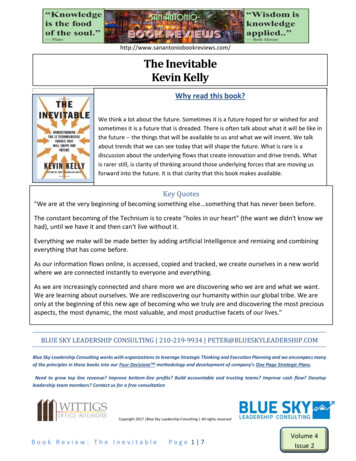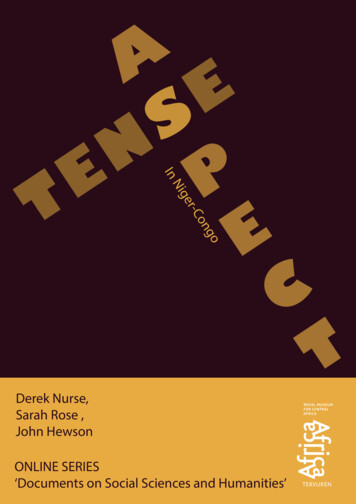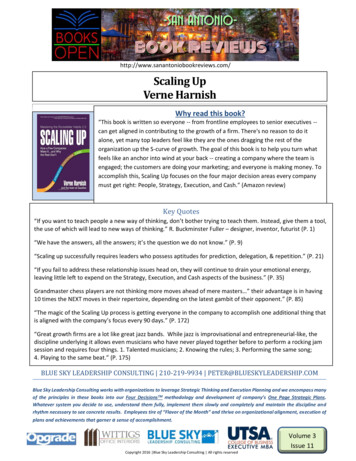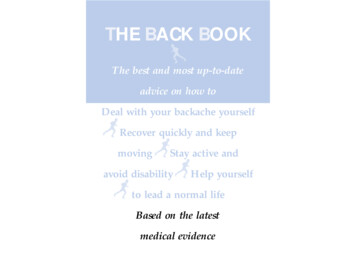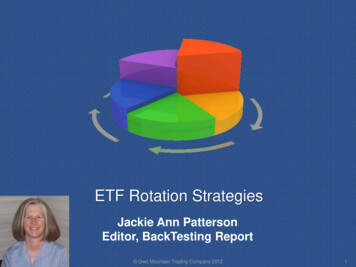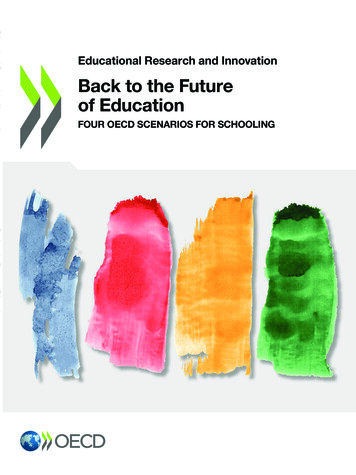
Transcription
Educational Research and InnovationBack to the Futureof EducationFOUR OECD SCENARIOS FOR SCHOOLING
Educational Research and InnovationBack to the Futureof EducationFOUR OECD SCENARIOS FOR SCHOOLING
This work is published under the responsibility of the Secretary-General of the OECD. The opinions expressed andarguments employed herein do not necessarily reflect the official views of OECD member countries.This document, as well as any data and map included herein, are without prejudice to the status of or sovereignty overany territory, to the delimitation of international frontiers and boundaries and to the name of any territory, city or area.Please cite this publication as:OECD (2020), Back to the Future of Education: Four OECD Scenarios for Schooling, Educational Research and Innovation, OECDPublishing, Paris, https://doi.org/10.1787/178ef527-en.ISBN 978-92-64-95813-5 (print)ISBN 978-92-64-96753-3 (pdf)ISBN 978-92-64-44396-9 (HTML)ISBN 978-92-64-36932-0 (epub)Educational Research and InnovationISSN 2076-9660 (print)ISSN 2076-9679 (online)Photo credits: Cover Shutterstock/colorfulset.Corrigenda to publications may be found on line at: www.oecd.org/about/publishing/corrigenda.htm. OECD 2020The use of this work, whether digital or print, is governed by the Terms and Conditions to be found at http://www.oecd.org/termsandconditions.
3Foreword2020, this evocative year of hindsight and foresight, has humbled us with a global shock: the COVID-19pandemic. We have been reminded that, despite the best laid plans, the truth is that the future likes tosurprise us. To prepare our education systems for what may come, we have to consider not only thechanges that appear most probable, but also the ones that we are not expecting.There are always multiple versions of the future – some are assumptions, others hopes and fears, or evensignals that something is already changing. Back to the future of education: Four OECD Scenarios forSchooling provides a set of scenarios on the future of schooling to support long-term strategic thinking ineducation. These scenarios, which build on the 2001 edition, show us that there is not a single path intothe future, but many.This volume is a companion volume to the Trends Shaping Education series, a triannual publication thathighlights key global megatrends and their potential impact on education. While megatrends focus onpatterns from the past to inspire thinking about the future, scenarios allow us to consider newly emergingpatterns and possibilities.A key question for thinking about the future of education is: To what extent are our current structureshelping or hindering our vision? Put another way, if today we were to meet with a Martian, freshly arrivedon planet earth and looking for tips on designing their own education system, what would we suggest?Would we suggest starting with schools and schooling as we know them now and advise modernising andfine-tuning the system, the conceptual equivalent of reconfiguring windows and doors of a house? Or wouldwe rather recommend an entirely different way to use the people, spaces, time and technology? Whowould be involved in these processes of transformation, and how much of the lifespan would it encompass(infancy? early childhood? adulthood, aligned to labour market? Or lifelong, including learning for our eldestseniors at 80 and 90 years, a growing cohort as our populations age?)?The path forward is likely a combination of these two approaches. Revisioning and transforming educationis a powerful tool, pushing us to think outside of the box and to go beyond our current limitations. So toois building on what we have, modernising the trusted institutions that play such an important role in thesocial fabric of our communities and societies.By using schools and schooling as a starting point, this volume and the four scenarios within it open thedoor to both approaches. They can be used to inspire, to dream, to transform. They can be used tofuture-proof systems and stress-test against unexpected shocks. Above all, they push us to move beyondcomplacency and easy solutions, presenting us with the tensions and paradoxes inherent in all our systemsand which we must address. We hope you enjoy the journey. Use them in good health.Andreas SchleicherDirector for Education and SkillsSpecial Advisor on Education Policy to the Secretary-GeneralBACK TO THE FUTURE OF EDUCATION: FOUR OECD SCENARIOS FOR SCHOOLING OECD 2020
4 AcknowledgementsThis book stems from and was inspired by past Centre for Educational Research and Innovation (CERI)work, from the original Schooling for Tomorrow scenarios, first published in 2001, to over a decade of workon Trends Shaping Education thereafter. We are indebted to David Istance, for many years a pillar of CERIand the leader of the transformative Schooling for Tomorrow and Innovative Learning Environmentsprojects, as well as the author, along with Henno Theisens, of Trends Shaping Education 2008, the firstedition in that highly successful series.In addition, the authors would like to thank Petra Packalen (Finnish National Agency for Education, and acontributor to Trends Shaping Education 2008) and Liana Tang (Centre for Strategic Futures, PrimeMinister’s Office, Singapore) for generously providing examples of how future thinking works in the practiceof national education policy. We would also like to thank our colleagues Duncan Cass-Beggs and JoshuaPolchar of the OECD Foresight Unit, for sharing their futures thinking expertise and working with us duringthe writing of this report. We also want to acknowledge Guim Tió’s generous help with the book cover.Thank you.The ideas compiled in this book benefited from many other projects within CERI and the wider OECDDirectorate for Education and Skills. We would like to thank all of our bright colleagues, whose rigorouswork made this analysis possible.In addition, the authors would like to thank present and past colleagues who provided expert ideas andsuggestions for improvement, to this volume as well as the overall process of developing these scenariosand our capacity to think more systematically about the future. From brainstorming analytical approachesto actively stress-testing versions of scenarios, we thank Liam Bekirsky, Mollie Dollinger, ManuelaFitzpatrick, Francesca Gottschalk, Marissa Miller, Joshua Polchar, Nóra Révai, Dhiman Talapatra, HannahUlferts and Ziyin Xiong as well as the numerous internal and external stakeholders who took part in ourFuture Labs. We also thank Andreas Schleicher, Director, and Dirk van Damme, interim Head of CERI, fortheir comments on the draft, and the CERI Governing Board, which provided encouragement, ideas, andfeedback throughout the process. We are grateful for their guidance.Within the Secretariat, this volume was produced as part of the work on Trends Shaping Education, underthe leadership of Tracey Burns. Marc Fuster led the analysis of the report, developing the scenarios anddrafting Chapters 3, 4 and 5. Tracey Burns authored Chapter 1 and contributed to the analysis and draftingof Chapters 4 and 5. Joshua Polchar authored Chapter 2 and additionally provided helpful comments onthe full draft. Simona Petruzzella and Dhiman Talapatra provided the graphics. Sophie Limoges andLeonora Lynch-Stein contributed to the final stages of preparation for publication.Marc Fuster and Tracey BurnsBACK TO THE FUTURE OF EDUCATION: FOUR OECD SCENARIOS FOR SCHOOLING OECD 2020
5Table of contentsForeword3Acknowledgements4Executive Summary71 Back to the future of education: Four OECD scenarios for schooling9Education for a changing worldMultiple futuresThe original OECD Schooling for Tomorrow scenariosThis volume: Four OECD Scenarios for the Future of SchoolingFinallyReferences2 Scenarios: A user guideIntroductionWhy do you need to think about the future?How do you think about the future?How do you use scenarios?ReferencesNotes3 Taking stock of the present: Trends in education and schooling1010111112121314141418202021IntroductionA front-end model of education continues to expandLearning for a world in changeTeachers, teaching and teacher policiesEvolution of education governanceConcluding remarksReferences222225272931314 The OECD Scenarios for the Future of Schooling39IntroductionLooking ahead: Four OECD Scenarios for the Future of SchoolingScenario 1: Schooling extendedScenario 2: Education outsourcedScenario 3: Schools as learning hubsScenario 4: Learn-as-you-goBACK TO THE FUTURE OF EDUCATION: FOUR OECD SCENARIOS FOR SCHOOLING OECD 2020404043464952
6 References555 Back from the future(s): Outcomes, implications and paradoxes56IntroductionContinuity and disruption: Dimensions and implications of the scenariosThe future of schooling: goals, tensions and paradoxesCodaReferences5757636970FIGURESFigure 3.1. An educated futureFigure 3.2. Potential stakeholders in educationFigure 5.1. What futures for schools and schooling?Figure 5.2. What futures for teachers and teaching?Figure 5.3. What future for education governance?2230586062INFOGRAPHICSInfographic 4.1. Overview: Four OECD Scenarios for the Future of SchoolingInfographic 4.2. Scenario 1: Schooling extendedInfographic 4.3. Scenario 2: Education outsourcedInfographic 4.4. Scenario 3: Schools as learning hubsInfographic 4.5. Scenario 4: Learn-as-you-go4144475053BACK TO THE FUTURE OF EDUCATION: FOUR OECD SCENARIOS FOR SCHOOLING OECD 2020
7Executive SummaryThere are always multiple versions of the future – some are assumptions, others hopes and fears. Toprepare, we have to consider not only the changes that appear most probable, but also the ones that weare not expecting. In 2020, the global COVID-19 pandemic has reminded us of how comfortableassumptions about the future may change in an instant.Back to the future of education: Four OECD Scenarios for Schooling is a tool to support long-term strategicthinking in education. Inspired by the ground-breaking 2001 OECD Schooling for Tomorrow scenarios,these scenarios can help identify potential opportunities and challenges and stress-test againstunexpected shocks. We can then use those ideas to help us better prepare and act now.Why scenarios?Scenarios are fictional sets of alternative futures. They do not contain predictions or recommendations.Imagining multiple scenarios recognises that there is not only one pathway into the future, but many.Chapter Two provides an overview of strategic foresight, highlighting three main benefits: 1) to reveal andtest assumptions, 2) stress-test and future-proof plans, and 3) generate shared visions of the future tosupport action in the present. The chapter sets out key steps for using the scenarios, including questionsfor identifying implications and taking strategic action.The four OECD Scenarios for the Future of SchoolingSCHOOLING EXTENDEDOECD s c e n ar i o sf or t he f ut ur e ofs chool i ngParticipation in formal education continues to expand. International collaboration andtechnological advances support more individualised learning. The structures and processesof schooling remain.E D U C AT I O N O U T S O U R C E DTraditional schooling systems break down as society becomes more directlyinvolved in educating its citizens. Learning takes place through more diverse,privatised and flexible arrangements, with digital technology a key driver.SCHOOLS AS LEARNING HUBSSchools remain, but diversity and experimentation have become the norm.Opening the “school walls” connects schools to their communities, favouring everchanging forms of learning, civic engagement and social innovation.LEARN-AS-YOU-GOEducation takes place everywhere, anytime. Distinctions between formal and informallearning are no longer valid as society turns itself entirely to the power of the machine.BACK TO THE FUTURE OF EDUCATION: FOUR OECD SCENARIOS FOR SCHOOLING OECD 2020
8 Understanding the present helps us think about the futureChapter Three looks at how education’s goals and functions, structures and organisation, and processesand practices have unfolded over the last two decades. It covers the continuing expansion of formaleducation and our evolving understanding of human learning. It addresses modern shifts in learningobjectives and looks at the ways in which education policy and practice works to prepare teachers, schoolsand systems to effectively respond to such changes.The four OECD scenarios are presented in Chapter Four along with key questions for discussion. Thescenarios have a time frame of approximately 20 years – long enough for significant change beyondimmediate political cycles, but not too remote for anyone except futurists and visionaries.What futures for schooling? Seven tensions and paradoxesEducation must evolve to continue to deliver on its mission of supporting individuals to develop as persons,citizens and professionals. In a complex and quickly changing world, this might require the reorganisationof formal and informal learning environments, and reimagining education content and delivery. In an ageingworld, these changes apply not just to basic education, but to lifelong learning as well.But, what is the best way to do this? Just as there is no “one” future, there is no single correct path to thefutures of education. And indeed, the future is not a place where problems will magically disappear. Byexploring, reflecting and preparing, we can respond to difficult challenges more effectively. Chapter Fivesets out seven inherent tensions that must be considered in this process:M O DERNI SI NGNEW G O ALSWhat can be incrementally improved, and whatneeds fundamental transformation?Are goals and structures aligned?How best to reconcile systemic goals withG LO BALlocal needs?I NNO VATI O NPO TENTI ALDoes the system allow for failures that comewith trying out new things?How to reconcile expectations withday to day reality?What is the balance between digital environmentsVI RTUALand old-fashioned physicality?LEARNI NGHow is being taught different from learning?DI SRUPTI NGO LD STRUCT U RE SLO CALRI SK AVO I DANC EREALI TYFACE - TO - FACEEDUCATI O NA large body of CERI work has focused on the need for education to be better informed by evidence,awareness of what is taking place in other places and at other times, and by the need to consider thebigger, long-term picture. This volume follows proudly in that tradition. In our rapidly changing world,education cannot rely on lessons of the past to prepare for the future. The future is here, and educationsystems need to learn from it. Our success will depend on how effectively we use our knowledge toanticipate the future, and how quickly we take action to shape it.BACK TO THE FUTURE OF EDUCATION: FOUR OECD SCENARIOS FOR SCHOOLING OECD 2020
91 Back to the future of education:Four OECD scenarios for schoolingOur world is in a perpetual state of change. There are always multipleversions of the future – some are assumptions, others hopes and fears. Toprepare, we have to consider not only the changes that appear mostprobable, but also the ones that we are not expecting. Inspired by theground-breaking 2001 Schooling for Tomorrow scenarios, this reportprovides four scenarios for the future of education to 2040, showing not asingle path into the future, but many. Using these scenarios can help identifythe opportunities and challenges that could be in store for education. We canthen use those ideas to help us better prepare and act now.BACK TO THE FUTURE OF EDUCATION: FOUR OECD SCENARIOS FOR SCHOOLING OECD 2020
10 Education for a changing worldOur world is changing. More people are being born and many of us are living longer. The unprecedenteddigital transformation of the global economy and society has increased connectivity of economic marketsand the ethnic, linguistic and cultural diversity of our societies. These changes are not cosmetic, but rathera fundamental transformation in the balance of economic power and ways in which we live.Education has been tasked with providing the skills and competencies needed to operate in this modernworld. It is a powerful tool to reduce inequity. However, while virtually all children and adolescents in OECDcountries participate in primary and lower secondary education, inequality – between countries andbetween individuals – is increasing, and the gap between rich and poor is at its highest level in 30 years.Education must evolve to continue to deliver on its mission of supporting individuals to develop as persons,citizens and professionals. It must remain relevant to continue to shape our children’s identity andintegration into society. In a complex and quickly changing world, this might require the reorganisation offormal and informal learning environments, and reimagining education content and delivery. In an ageingworld, these changes are likely to apply not just to basic education, but to lifelong learning as well.By providing the competencies needed to operate in the modern world, education has the potential toinfluence the life outcomes of the most disadvantaged. It can help combat the increasing fragmentationand polarisation of our societies, and empower people and communities to take charge of their own civicprocesses and democratic institutions. Access to learning and knowledge not only opens doors toindividual and collective opportunities, it has the potential to reshape the future of our global world.But the future is inherently unpredictable, because it is always in the making. Close your eyes and thinkof something that happened over the last 20 years that you would never have expected. Be it thecoronavirus pandemic, the invention and ubiquity of smart phones or something else, the truth is that thefuture likes to surprise us. This convoluted year 2020 is a reminder of how our comfortable assumptionsabout the future may change in an instant. Although challenging, this is a call to action, a reminder that wecan better prepare for both seen and unforeseen futures if we so choose.Multiple futuresTraditionally, the year 2020 has held great allure for future thinkers. At the turn of the 20th century,imagining life in the distant time of 2020 generated rich predictions, from everyone living in houses that flyto not needing transport at all, because we can all teleport. Even half-way through that century, predictionsfor 2020 were something of a fad, and it was not the case that being closer in time made them moreaccurate:“By 2020 we could have well-trained animal employees, including apechauffeurs.” (RAND Corporation Long-Range Forecasting Study,1968)Much of our thinking of the future is linear, and based on extending currently existing trends. But trendsslow, accelerate, bend and break. Unforeseen events can disrupt even long-standing trends. Opinionsdiffer on historical developments and, even when there is agreement, the future is rarely just a smoothcontinuation of past patterns. Moreover, we do not know in advance which trends will continue and whichwill change course, or in what context. Sometimes, we can just be plain wrong.BACK TO THE FUTURE OF EDUCATION: FOUR OECD SCENARIOS FOR SCHOOLING OECD 2020
11“The horse is here to stay but the automobile is only a novelty – a fad.”(President of Michigan Savings Bank, warning Henry Ford’s [inventorof the automobile] lawyer not to invest in the Ford Motor Company,1903)In the absence of concrete facts or evidence about the future, the only way to meaningfully understand thefuture is through dialogue. The future cannot be passively observed. It must be actively discussed in orderto learn from it and identify and agree upon actions for today. Imagining multiple scenarios for the futurethus recognises that there is not only one pathway into the future, but many (OECD, 2001[1]).Scenarios are more than just an extrapolation of a given trend, but they can take trends into account bydescribing how the future might look if one or more trends were to continue (or change course). Scenariosthemselves have no intrinsic value; it is the process of creating or using them in the context of strategicdialogue that makes them worthwhile.The original OECD Schooling for Tomorrow scenariosIn 2001 the OECD/CERI programme “Schooling for Tomorrow” published a set of six futures thinkingscenarios. Aimed at sharpening understanding of how schooling might develop in the years to come andthe potential role of policy to help shape these futures, the scenarios brought together the “big picture” ofstrategic goals for education intertwined with the complex and the long-term processes of change.Intentionally fictional, the scenarios did not contain predictions or recommendations. Rather, as with allscenarios, they were constructed for the purpose of learning and taking action in the present. This wasachieved by generating, testing, and reframing ideas about what might happen.At the time, the authors noted that “Perhaps surprisingly, forward thinking has been relatively littledeveloped in education compared with other policy sectors, despite education’s fundamental characteristicof yielding benefits over very long time spans” (OECD, 2001, p. 77[1]). In the almost two decades since,future thinking in education has become more popular but it has tended to coalesce around aspirationalvisions and roadmaps of desirable futures. These aspirational visions have been used to set agendas andspark dialogue among diverse groups of stakeholders about the curriculum, pedagogy and system deliverythat would be needed to make these visions a reality.Although powerful, by focusing on the delivery of a desired future, those approaches do not preparesystems for unexpected shocks. They do not take into account that the future likes to surprise us. Beingfuture-fit in a challenging and uncertain context requires identifying a number of different plausible futurescenarios, exploring what impacts they could have and identifying potential implications for policies. Thisvolume aims to do this, using as its starting point the 2001 Schooling for Tomorrow Scenarios. Connectingto broader futures thinking across policy domains and revisiting and updating the scenarios from almost20 years ago, this report provides four scenarios for the future(s) of education.This volume: Four OECD Scenarios for the Future of SchoolingAfter this introduction, Chapter Two provides a brief sketch of strategic foresight methods. It looks atelements of a foresight system and how one might begin to think about using foresight and future thinkingmethodologies as a way to plan and prepare future-fit systems. Strategic foresight is required wheneverthere is a high degree of uncertainty surrounding changes to the relevant future context. This applies asmuch to broad national decisions as to decisions in particular sectors or policy domains such as education.BACK TO THE FUTURE OF EDUCATION: FOUR OECD SCENARIOS FOR SCHOOLING OECD 2020
12 Two examples from very diverse education systems – Finland and Singapore – are provided to illustrateconcretely some of the ways strategic foresight plays out in education.Chapter Three offers an overview of some of the main trends in education policy and practice in the lastdecades. It begins with a look at how education has become massified and expanded, reaching morepeople and increasingly extending throughout the lifespan. It outlines the rising expectations for educationand their impacts on multiple areas of schooling and instruction, from evaluation, assessment andcertification processes to teaching and teacher polices. The chapter also looks at how educationgovernance has changed and what impacts that has had on our design, delivery and expectations for thefuture of the sector.Chapter Four provides a set of four scenarios for the future of schooling to 2040. They have beenconstructed in a time frame of approximately 20 years – long enough for significant change to occur beyondimmediate political cycles, but not so far off as to be too remote for anyone except futurists and visionaries.The alternative futures are a) schooling extended; b) an outsourcing of education and resulting surge oflearning markets; c) schools as learning hubs and d) the end of school-based learning and demise ofschooling more generally.The volume ends with Chapter Five, which looks at the key implications and tensions that emerge fromthe scenarios. It explores the policy questions that become visible when imaging these multiple futures.Just as the goals that schools work towards are various and complex, so too are the potential futures thatunfold as they are intertwined with the daily reality of the school and its defining processes. The chapterdoes not provide direct answers; as those emerge in the use and consideration of the scenarios within aspecific context. Rather, it highlights those areas that deserve closer attention and where further discussioncan be most valuable.FinallyAs the methodologies for educational forward-thinking remain under-developed, there is much to be donein building a “toolbox” of such approaches to inform the policy-making process. Scenarios are one vehiclefor doing this. By stimulating dialogue at multiple levels and among key stakeholders, the scenarios comealive with the realities of a particular country or setting. The scenarios are not meant to be understood aspolished final statements about the future but the starting point for a process of genuine engagement. Thisbook is meant to challenge, to inspire, to stimulate critical and creative thinking on the multiple futures ofeducation.A large body of CERI work has been founded on the need for educational decision-making to be betterinformed by evidence, by awareness of what is taking place in other places and at other times, and by theneed to consider the bigger, long-term picture. This volume follows proudly in that tradition.ReferencesOECD (2001), What Schools for the Future?, Schooling for Tomorrow, OECD Publishing, [1]BACK TO THE FUTURE OF EDUCATION: FOUR OECD SCENARIOS FOR SCHOOLING OECD 2020
132 Scenarios: A user guideAttempting to predict or forecast the future is of limited benefit in a world ofhigh uncertainty. What is highly valuable, however, is to identify a number ofdifferent plausible future scenarios, explore what impacts they could haveand identify potential implications for policies. Scenarios are sets ofalternative futures in the form of snapshots or stories giving an image of afuture context. They are intentionally fictional, and never contain predictionsor recommendations. Scenarios do not consider what will happen, or whatshould happen; only what might happen. Participation and dialogue areindispensable to the effective use of scenarios. Through purposing,exploring, identifying implications, and taking strategic action, scenarios helpus learn from the future to reframe and reperceive our understanding of thepresent.BACK TO THE FUTURE OF EDUCATION: FOUR OECD SCENARIOS FOR SCHOOLING OECD 2020
14 IntroductionThe purpose of this chapter is to explain how scenario planning can be used by a variety of audiences,those who want to use ideas about futures that haven’t occurred to play their part in shaping the future thatwill. For those wishing to become practitioners of strategic foresight or to create their own scenarios, pleaserefer to the many resources on this topic.1Why do you need to think about the future?Education systems currently face multiple pressures, including economic disruption; international tensions;polarisation and declining trust; large-scale migration; and ageing populations. The immediacy of today’schallenges often means that governments fail to take the time to step out of the here and now and engagewith the future at all (Fuerth and Faber, 2012[1]). At the same time, the future will be no less challenging:climate-related crises, further digitalisation of economies and societies, and new forms of politicalturbulence both at home and abroad could make for a future that is very different from what is commonlyexpected.What does it mean to be future-fit in such a challenging context? Attempting to predict or forecast the futureis of limited benefit in a world of high uncertainty. What is highly valuable, however, is to identify a numberof different plausible future scenarios, explore what impacts they could have and identify potentialimplications for policies. It is also important to look beyond the scope of traditional policy silos and considerhow multiple developments can intersect and interact in unexpected ways. Change may be happeningfurther and faster than our deliberative (and sometimes lengthy) policy processes are designed to copewith, and when change grows exponentially, so too must an education system’s ability to respond to it.How do you think about the future?Strategic foresight is a discipline which involves the structured consideration of ideas about the future toidentify ways to make better decisions in the present. It is founded on the principle that our ability to predictthe future is always limited, but that it is possible to make wise decisions anyway by imagining and usingmultiple futures. Strategic foresight is required whenever there is a high degree of uncertainty surroundingchanges to the relevant future context. This applies as much to broad national decisions as to decisions inparticular sectors or policy domains such as education. Strategic foresight has three main benefits: Anticipation: identifying what’s changing and how to prepare for it; avoiding blind spots; consideringdevelopments that do not seem intuitively relevant, likely, or impactful, but which could catch us bysurprise. Policy innovation: revealing options for action that make sense in new circumstances, and whichreframe or refresh our understanding of the present. Future-proofing: stress-testing existing plans, strategies, or policies by subjecting them to varying
May 12, 2020 · There are always multiple versions of the future – some are assumptions, others hopes and fears, or even signals that something is already changing. Back to the future of education: Four OECD Scenarios for Schooling provides a set of scenarios on the future of schooling to support lo


